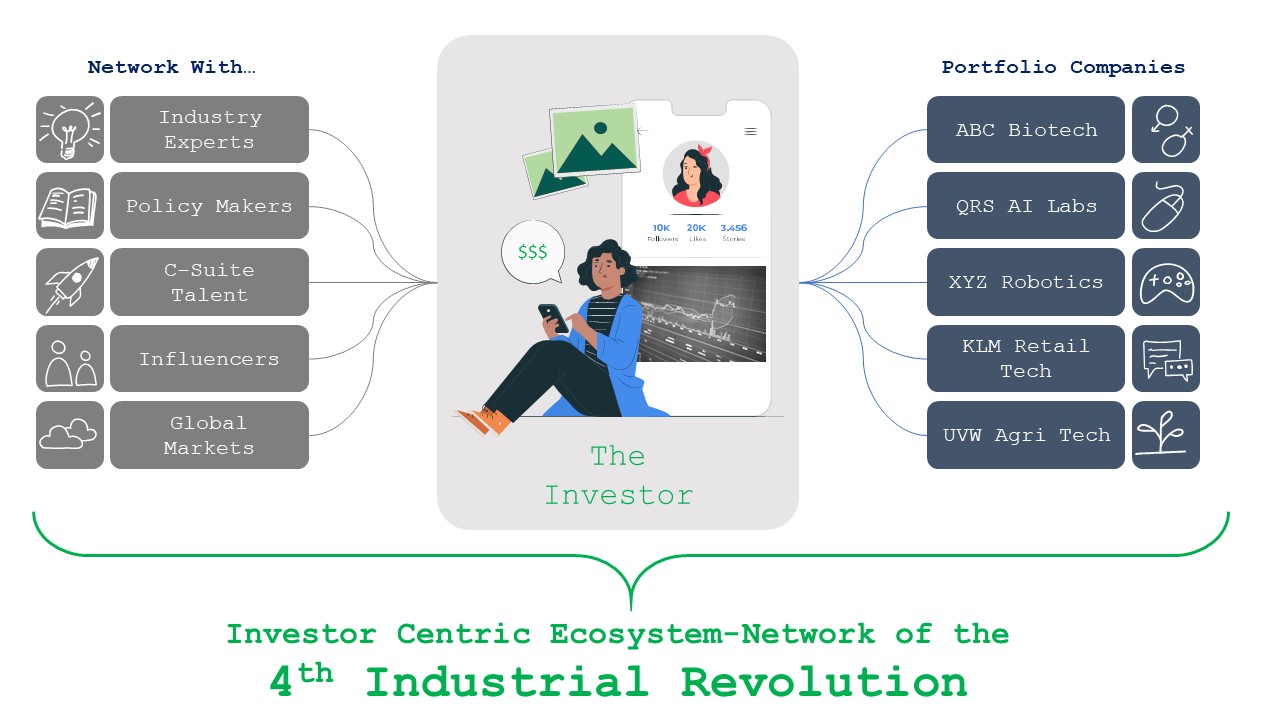Investors to Lead the 4th Industrial Revolution
By: White Whole Hub (WHH)

The first three revolutions changed the way we live, think, work, and innovate. Starting from the mechanisation of labour-intensive tasks to mass production and robotic automation, these revolutions make the world of manufacturing a marvel. The two common features of these three revolutions are their focus on manufacturing and their birth from inventions. These revolutions were interconnected in a way that they started from mechanisation, amplified for the scale and automated for the productivity uplift.
The 4th revolution, which we are now part of, is significantly different from its predecessors. The 4th revolution is all about connectivity. Integral to its success is the ability of an ecosystem to interconnect various modular solutions into a single working component. While the first three revolutions were driven by inventors, scientists, and engineers, the 4th one needs a super networker to champion the success. This is where our investors would lead the revolution from the front end.
Investor as a Networker
Investor, by definition, is not the one with the money but the one who is making the decision to invest. The former is a financier. Investor community has an unwavering passion to learn more about anything and everything. Imagine a venture capital (VC) fund principle, private equity (PE) portfolio manager, or hedge fund analyst; these are the investors. Part of their jobs is to talk to a variety of subject matter experts and get a notional sense of the future.
A typical investor would have access to a net spanning across c-suite executives of Fortune 500 companies, lawmakers, partners in consulting firms, fellow investors, analysts of large banks, and freelance exceptional talent. They use the information gathered from this wide net to make investment decisions.
Over time, as the information becomes knowledge, they do help the founders of their portfolio companies to define strategy, circumvent the hurdles, and achieve the goals. Of the many tools and tricks in an investor’s hat, the most frequently used one is their impeccable sense of leveraging their network to prosper a portfolio company, and then make a successful exit. More than their deep pockets, VC/PE funds boast about their wide network of eminent thought leaders, and their ability to tap talent at will. For them, their network is their net worth.

With a gargantuan network and strong branding, the network effect of investors serves as effective launchpads for your business.
How “Network = Success”
The rumour is that an idea occurs to at least seven people across the world, at the same time. Thus, ideas are not inherently unique. And startups are not unique either. When Google was launched, there were already 100+ search engines in the market. Facebook was not the first social network. Tesla was not the first electric car company. The point is, with the same idea and similar product, some start-ups succeed while others fail. There are many reasons, including the attitude of the co-founders, the market conditions (also known as “luck”), geographic presence, lean operations, no-too-greedy investors, credible mentors, and a thorough business model.
One abstract factor of success is the network effect of the founders, investors, and mentors. Google had Ram Shriram of Netscape and Jeff Bezos of Amazon as the first angel investor. Imagine their network effect on Google’s success. Facebook had blessings from the guru Peter Thiel (PayPal co-founder) and Sean Parker (the notorious Napster). Tesla had Elon Musk and then Google as the early investors. It was not their money that mattered. It was the power of ruthless branding and gargantuan network these investors brought with them. These strongly connected “celebrities” of silicon valley opened the doors of customers, business partners, regulators, and future financiers.
Google, Facebook, and Tesla are a few of the many progenitors of the 4th revolution. In the coming years of the 4th revolution, having a strong network would become a non-negotiable trait for the success of startups, ecosystems, and the revolution itself.

4IR technologies do not function in silos, rather they function optimally as an interconnected network.
“Investor + Network” = “4th Industrial Revolution + Success”
The pillars of the 4th revolution are artificial intelligence, the internet of things (IoT), robotics, biotechnology, 3D printing, and augmented reality. None of these themes work in isolation. The outcome of the 4th industrial revolution is a connected collective consciousness powered by its pillars.
For example, a biotechnology company that is 3D printing human tissues is fully automated (run by robots), and is connected to the outer world by IoT. The co-founders of this biotech company would need to focus on their product (and its sales), while also collaborating with the 3D printing partners, providers of robots, and IoT vendors. To best divide and conquer, the investors would pitch in to manage the latter part of bringing in the best partners for ensuring success.
Investors are the connecting glue between all the pieces of the puzzle. In many ways, the trophy of accomplishment would be equally lifted by the co-founders and their valuable investors.

Treat your investors like co-founders and they might just lead you to success.
Conclusion and Recommendations
For the start-up, treat your investors like co-founders. Choose them wisely. They are the key to every door. Do not go with the one that provides the highest valuation, but with the one that provides the highest value.
For the financiers, groom more investors that are super networkers. For the industry, align the investors with a complementary skillset. The VC/PE funds would transform from being very niche at present to being very generic at least. This would help them to better interconnect their portfolio companies and complement their offerings. The VC/PE/Hedge funds would create a complete ecosystem of their own. For example, an IoT company in their portfolio would use AI modules of another portfolio company, and would sell its services to an augmented reality company from the same portfolio.
Investors would become the epicentre of synergy and symbiosis. Imagine a 100% automated organic urban farm, selling its produce through a wellness platform, powered by the data collected from wearable devices (IoT). On top of this, all these companies are incubated/invested by the common investor(s). This is the role of Investors in the 4th industrial revolution, in a nutshell.
White Hole Hub (WHH) is a start-up accelerator based out of Singapore. At the time of inception, the co-founders identified a gap in the start-up ecosystem of emerging markets: the majority of start-ups fail to make an impact, not because of their fault, but their limitation to tap into the right network at the moment of need. It is unfortunate for any venture to fail! WHH helps investors and start-ups in getting access to the right investments opportunities, right ventures, and handhold the portfolio to companies to become a global success.



